Warning Letter For Poor Or Unsatisfactory Performance
[Your Name]
[Your Title/Position]
[Company Name]
[Company Address]
[City, State, Zip Code]
[Date]
[Employee's Name]
[Employee's Position]
[Department/Team Name]
[Company Address]
[City, State, Zip Code]
Subject: Warning Letter for Poor or Unsatisfactory Performance
Dear [Employee's Name],
I hope this letter finds you well. We are writing to address a matter of concern regarding your performance at [Company Name]. As an essential member of our team, it is vital for us to maintain high standards of productivity and quality. However, it has come to our attention that your recent performance has been consistently falling short of expectations.
Specifically, the following areas have been identified as areas of concern:
1. [Specify the first area of poor performance, e.g., meeting deadlines]
2. [Specify the second area of poor performance, e.g., lack of attention to detail]
3. [Specify the third area of poor performance, e.g., communication issues]
We believe in providing ample support and opportunities for improvement to our employees. To that end, we have taken the following steps to help you succeed:
1. Regular performance feedback and coaching
2. Additional training and resources as needed
3. Setting clear performance expectations and objectives
Despite our efforts to assist you, we have not witnessed the desired improvement in your performance. It is essential for you to understand that your role at [Company Name] requires consistent and satisfactory performance.
Therefore, this letter serves as an official written warning regarding your poor or unsatisfactory performance. You are expected to take immediate and sustained action to address the identified concerns and bring your performance up to the required standards.
To assist you further, we have scheduled a meeting on [Date and Time] with your immediate supervisor or manager. During this meeting, you will have the opportunity to discuss your challenges, ask questions, and receive guidance on how to improve your performance.
Failure to make significant progress and show improvements within the specified period may result in further disciplinary action, up to and including termination of employment.
We strongly encourage you to take this warning seriously and proactively work towards enhancing your performance. Remember that your success is essential to the success of the entire team and the company.
Please sign the acknowledgment below to confirm that you have received this warning letter. If you wish to provide any comments or additional information, you may do so in the space provided.
Acknowledgment:
I, [Employee's Name], acknowledge receipt of this warning letter and understand the areas of my performance that require improvement. I commit to addressing these concerns and working diligently to improve my performance.
Employee's Signature: _____________________
Date: _____________________
Supervisor's Signature: ____________________
Date: _____________________
Human Resources Representative (if applicable): ____________________
Date: _____________________
This letter is a serious step towards rectifying the performance concerns, and we sincerely hope to see significant improvements in your work. If you have any questions or need further support, do not hesitate to reach out to your supervisor or the HR department.
Sincerely,
[Your Name]
[Your Title/Position]
[Company Name]
Formal Warning Letter for Unsatisfactory Performance
Subject: Warning Regarding Unsatisfactory Performance
Dear [Employee Name],
This letter serves as a formal warning regarding your recent unsatisfactory performance in your role as [Position]. Despite previous discussions and performance reviews, we have observed continued lapses in meeting the expected standards of your responsibilities, particularly in [specific areas].
We request immediate improvement and adherence to the performance expectations outlined in your job description. Failure to show satisfactory progress within [time frame, e.g., 30 days] may result in further disciplinary action, including possible termination.
Please consider this letter as a serious notice and take necessary steps to improve your performance.
Sincerely,
[Manager Name]
[Designation]
Casual Warning Email for Poor Performance
Hi [Employee Name],
I wanted to reach out regarding your recent performance in [specific tasks or projects]. We’ve noticed some areas where expectations aren’t being met.
Please take this as a prompt to review your work and make necessary improvements. Let’s schedule a quick discussion to identify challenges and find ways to support you.
Thanks,
[Manager Name]
Serious Performance Warning Letter
Subject: Immediate Attention Required – Performance Concerns
Dear [Employee Name],
Following our recent evaluations, it has been noted that your performance continues to fall below the required standards for your position. Key areas of concern include [specific examples].
You are required to develop an action plan to address these deficiencies and demonstrate measurable improvement within [time frame]. Continued underperformance may result in further disciplinary action, including termination.
We hope you take this matter seriously and act promptly.
Sincerely,
[Manager Name]
[Designation]
Informal Reminder Message for Performance Improvement
Hi [Employee Name],
I wanted to quickly touch base regarding some areas in your work that need improvement, especially [specific tasks]. Please take the necessary steps to address these issues.
We are here to support you if you need guidance or resources.
Best,
[Manager Name]
Provisional Warning Letter Before Final Action
Subject: Provisional Warning Regarding Performance
Dear [Employee Name],
This letter is to inform you that your recent performance in [specific areas] has been unsatisfactory. This is a provisional warning, and you are required to improve within [time frame] to avoid formal disciplinary measures.
Please document your plan for improvement and submit it to your supervisor by [date]. Support and guidance are available to help you meet the required standards.
Sincerely,
[Manager Name]
What / Why of a Warning Letter for Poor Performance
Purpose of a Warning Letter for Unsatisfactory Performance
- A warning letter is a formal communication highlighting areas where an employee's performance is below expectations.
- Serves as an official record for the company documenting performance issues.
- Provides an opportunity for the employee to understand deficiencies and improve.
- Helps prevent further disputes or misunderstandings about performance expectations.
Who Should Send a Warning Letter
Responsible Parties
- Immediate supervisors or managers of the employee.
- HR personnel may co-author or approve the letter for compliance purposes.
- Department heads for serious or repeated performance issues.
Whom Should Receive a Warning Letter
Recipients
- Employees whose work or behavior is under review for poor performance.
- In some cases, copies may be filed with HR or relevant authorities within the company for documentation.
When to Issue a Warning Letter
Triggering Scenarios
- Repeated failure to meet performance targets.
- Missing deadlines or not completing assigned tasks.
- Persistent quality issues or customer complaints.
- Lack of improvement after verbal counseling or informal discussions.
- As part of a progressive disciplinary process before stronger measures.
How to Write and Send a Warning Letter
Steps for Effective Communication
- Identify specific performance issues with examples.
- Maintain a professional and objective tone.
- State expectations and required improvements clearly.
- Include a reasonable time frame for correction.
- Mention consequences for continued underperformance.
- Send via official email or printed letter, ensuring documentation in HR files.
- Offer support or resources to assist improvement.
Requirements and Prerequisites Before Sending
Checklist Before Issuing a Warning
- Gather evidence of performance deficiencies (reports, feedback, metrics).
- Confirm previous verbal warnings or informal guidance were provided.
- Align with HR policies and disciplinary guidelines.
- Ensure clarity on measurable expectations for improvement.
Formatting a Warning Letter
Formatting Guidelines
- Length: One page; concise but specific.
- Tone: Professional, clear, and objective; avoid emotional language.
- Style: Formal for documentation, casual for minor reminders.
- Structure: Subject line, greeting, performance details, expectations, consequences, closing.
- Include signature and date.
After Sending / Follow-up Actions
Post-Issuance Steps
- Schedule a follow-up meeting to review improvement.
- Monitor performance against stated expectations.
- Document progress or lack thereof in HR records.
- Consider further action if improvements are not met, including probation or termination.
Pros and Cons of Sending a Warning Letter
Advantages
- Provides clear documentation of performance issues.
- Encourages improvement by setting measurable expectations.
- Protects company legally in case of future termination.
Disadvantages
- Can impact employee morale if not handled carefully.
- May create tension between employee and supervisor.
- Requires monitoring and follow-up, increasing managerial responsibility.
Common Mistakes in Warning Letters
Pitfalls to Avoid
- Being vague or non-specific about performance issues.
- Using accusatory or emotional language.
- Failing to provide a clear improvement plan or time frame.
- Neglecting to document previous verbal warnings.
- Ignoring company policies or labor regulations.
Elements and Structure of a Warning Letter
Key Components
- Subject line indicating the purpose.
- Formal greeting.
- Description of performance issues with specific examples.
- Reference to previous discussions or warnings.
- Clear expectations and improvement requirements.
- Consequences for continued underperformance.
- Closing statement and signature.
- Date and official HR record notation.
Tricks and Tips for Effective Warning Letters
Best Practices
- Keep tone professional and non-accusatory.
- Provide actionable guidance for improvement.
- Document all communications for accountability.
- Use clear, measurable performance indicators.
- Offer support, training, or resources where applicable.
- Follow up consistently within the stated time frame.
Compare and Contrast with Other Disciplinary Actions
Comparison
- Verbal Warning: Less formal, no permanent documentation; suitable for minor issues.
- Written Warning (Letter): Formal, documented, sets expectations and consequences; used for ongoing performance issues.
- Final Warning or Termination Notice: Used after written warnings fail; formal and legally documented.
- Warning letters balance fairness, documentation, and opportunity for improvement before serious action.

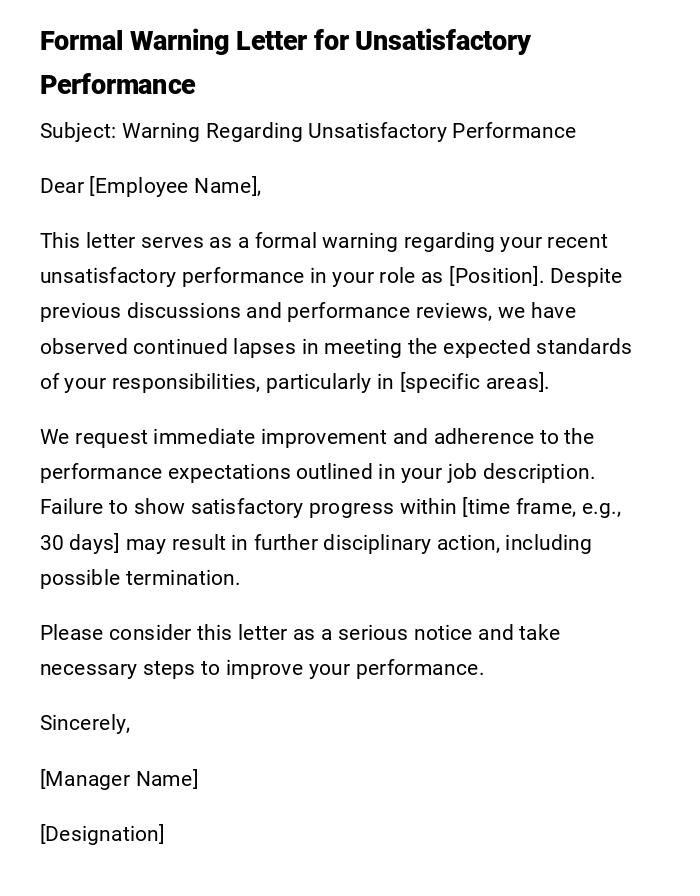
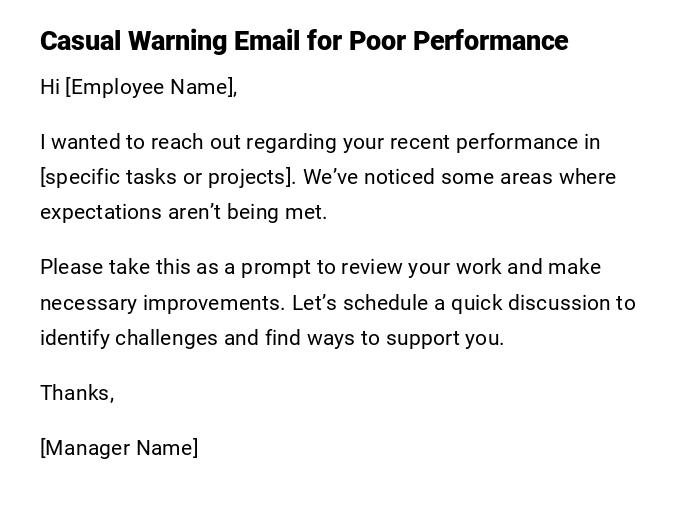
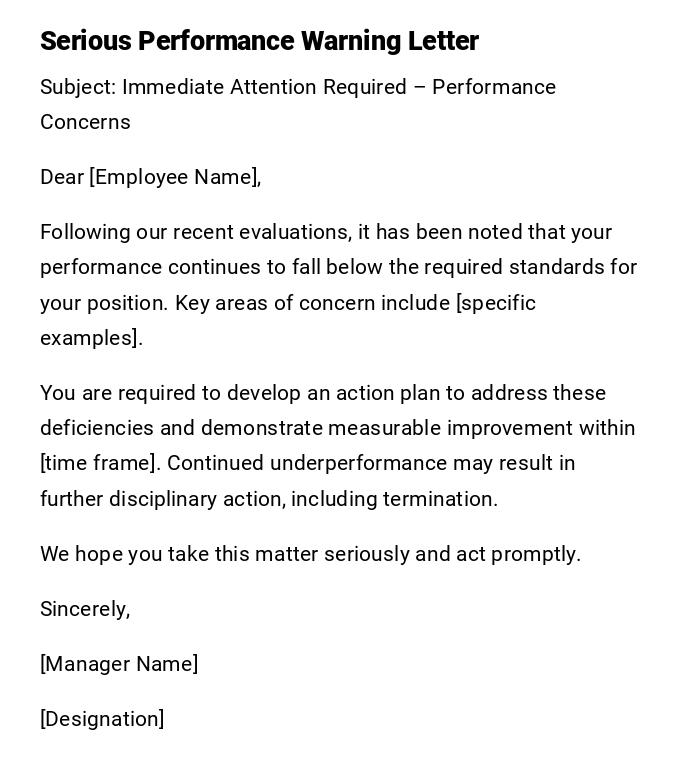
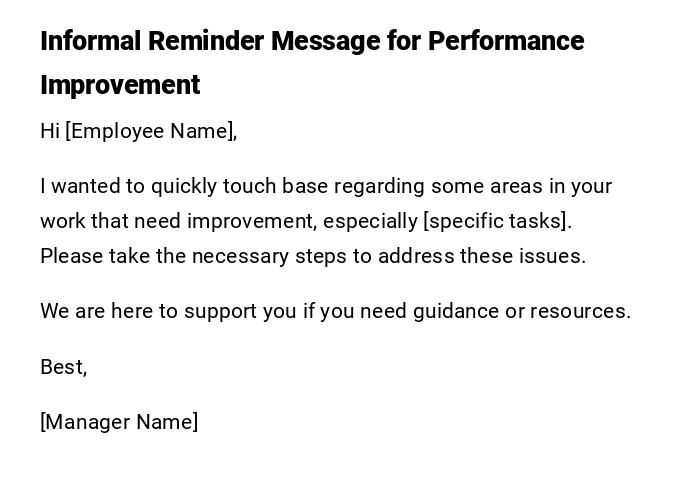
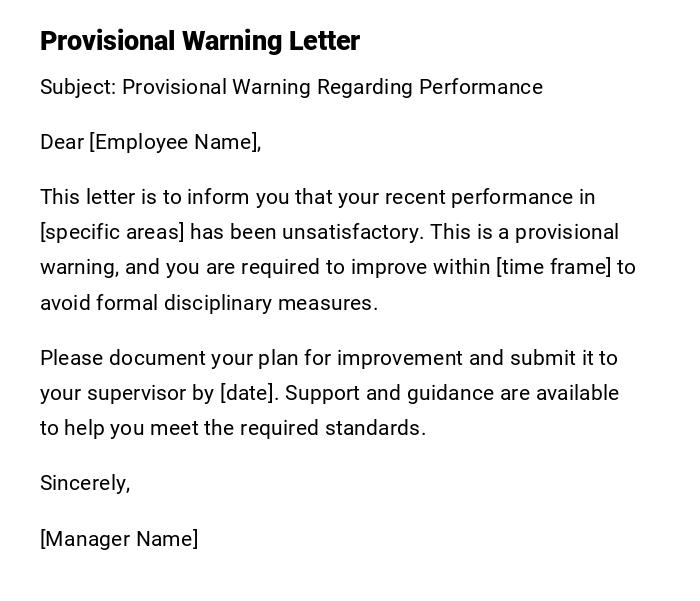

 Download Word Doc
Download Word Doc
 Download PDF
Download PDF